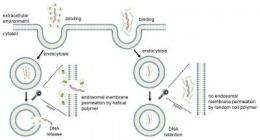Let's do the twist: Spiral proteins are efficient gene delivery agents

Clinical gene therapy may be one step closer, thanks to a new twist on an old class of molecules.
A group of University of Illinois researchers, led by professors Jianjun Cheng and Fei Wang, have demonstrated that short spiral-shaped proteins can efficiently deliver DNA segments to cells. The team published its work in the journal Angewandte Chemie.
"The main idea is these are new materials that could potentially be used for clinical gene therapy," said Cheng, a professor of materials science and engineering, of chemistry and of bioengineering.
Researchers have been exploring two main pathways for gene delivery: modified viruses and nonviral agents such as synthetic polymers or lipids. The challenge has been to address both toxicity and efficiency. Polypeptides, or short protein chains, are attractive materials because they are biocompatible, fine-tunable and small.
"There are very good in vitrotransfection agents available, but we cannot use them in vivo because of their toxicity or because some of the complexes are too large," Cheng said. "Using our polypeptides, we can control the size down to the 200 nanometer range, which makes it a very interesting delivery system for in vivo applications."
A polypeptide called poly-L-lysine (PLL) was an early contender in gene delivery studies. PLL has positively charged side chains – molecular structures that stem from each amino acid link in the polypeptide chain – so it is soluble in the watery cellular environment.
However, PLL gradually fell into disuse because of its limited ability to deliver genes to the inside of cells, a process called transfection, and its high toxicity. Cheng postulated that PLL's low efficiency could be a function of its globular shape, as polypeptides with charged side chains tend to adopt a random coil structure, instead of a more orderly spiral helix.
"We never studied the connections of conformation with transfection efficiency, because we were never able to synthetically make materials containing both cationic charge and a high percentage of helical structures," Cheng said. "This paper demonstrated for the first time that helicity has a huge impact on transfection efficiencies."
Earlier this year, Cheng's group developed a method of making helical polypeptides with positively charged side chains. To test whether a helical polypeptide could be an efficient gene delivery agent, the group assembled a library of 31 helical polypeptides that are stable over a broad pH range and can bond to DNA for delivery. Most of them outperformed PLL and a few outstripped a leading commercial agent called polyethyleneimine (PEI), notorious for its toxicity although it is highly efficient. The helical molecules even worked on some of the hardest cells to transfect: stem cells and fibroblast cells.
"People kind of gave up on polypeptide-based materials for gene deliveries because PLL had low efficiency and high toxicity," Cheng said. "The polypeptide that we designed, synthesized and used in this study has very high efficiency and also well-controlled toxicities. With a modified helical polypeptide, we demonstrated that we can outperform many commercial agents."
The polypeptides Cheng and his co-workers developed can adopt helical shapes because the side chains are longer, so that the positive charges do not interfere with the protein's winding. The positive charges readily bind to negatively charged DNA, forming complexes that are internalized into cellular compartments called endosomes. The helical structures rupture the endosomal membranes, letting the DNA escape into the cell.
To confirm that the spiral polypeptide shape is the key to transfection, the researchers then synthesized two batches of the most efficient polypeptide: one batch with a helical shape, one with the usual random coil. The helical polypeptide far exceeded the random-coil polypeptide in both efficiency and stability.
"This demonstrates that the helicity is very important, because the polymer has exactly the same chemical makeup; the only difference is the structure," said Cheng, who also is associated with the Institute for Genomic Biology and the Beckman Institute for Advanced Science and Technology, both at the U. of I.
Next, the researchers plan to further explore their helical polypeptides' properties, especially their cell-penetrating abilities. They hope to control sequence and structure with precision for specific applications, including gene delivery, drug delivery, cell-membrane penetration and antimicrobial action.
More information: The paper, "Reactive and Bioactive Cationic α-Helical Polypeptide Template for Nonviral Gene Delivery," is available online on Angewandte Chemie.
Journal information: Angewandte Chemie
Provided by University of Illinois at Urbana-Champaign


















